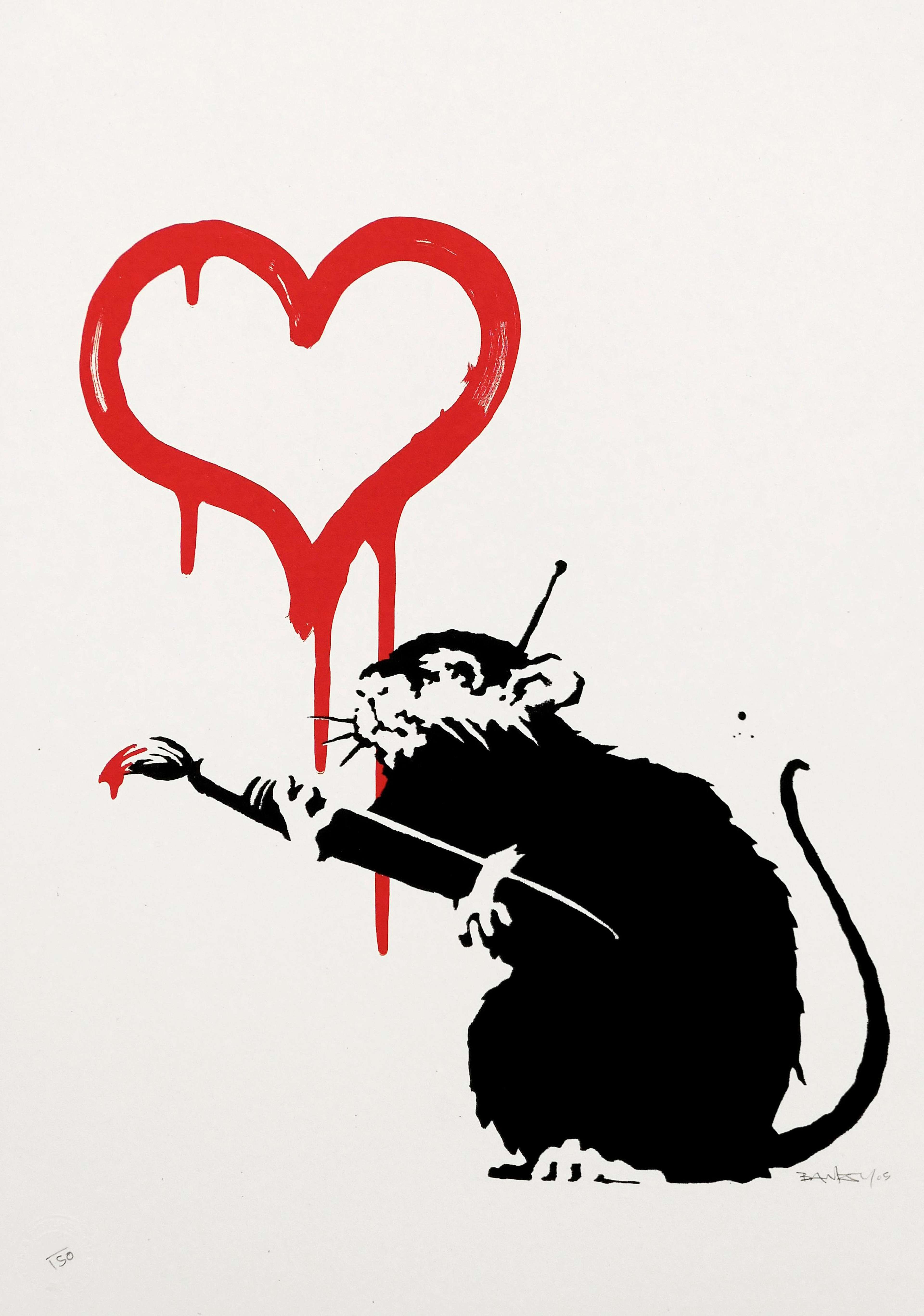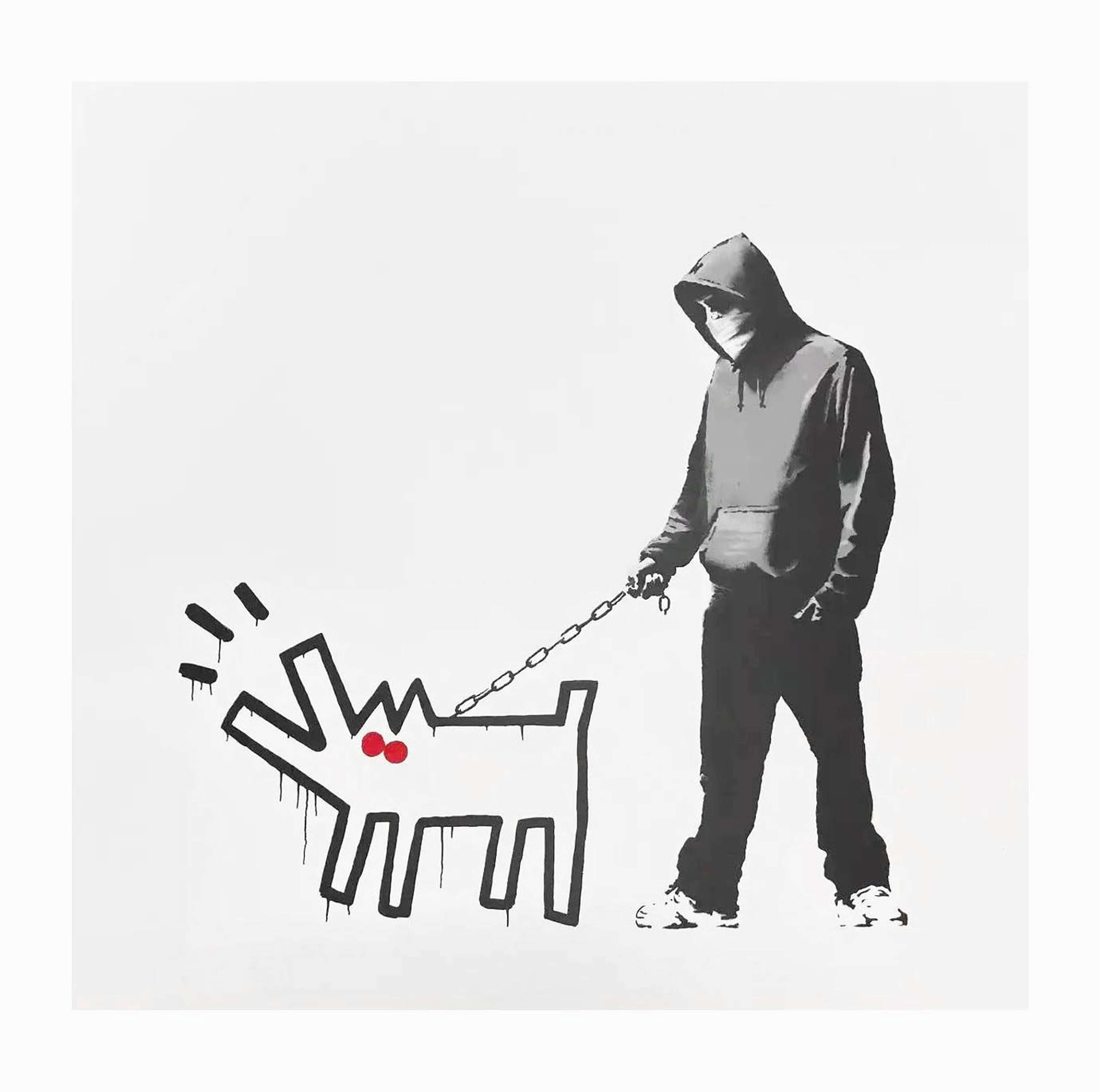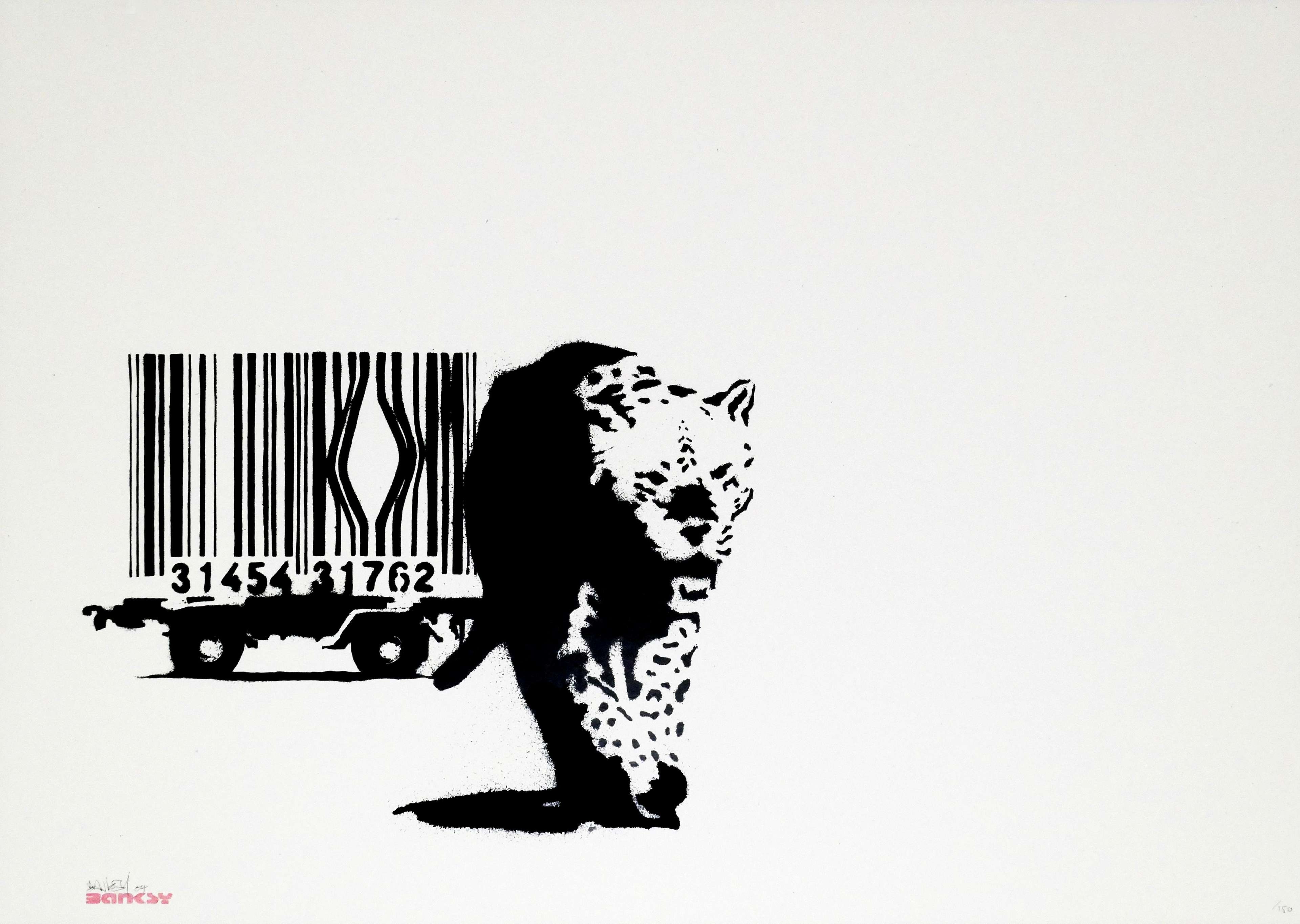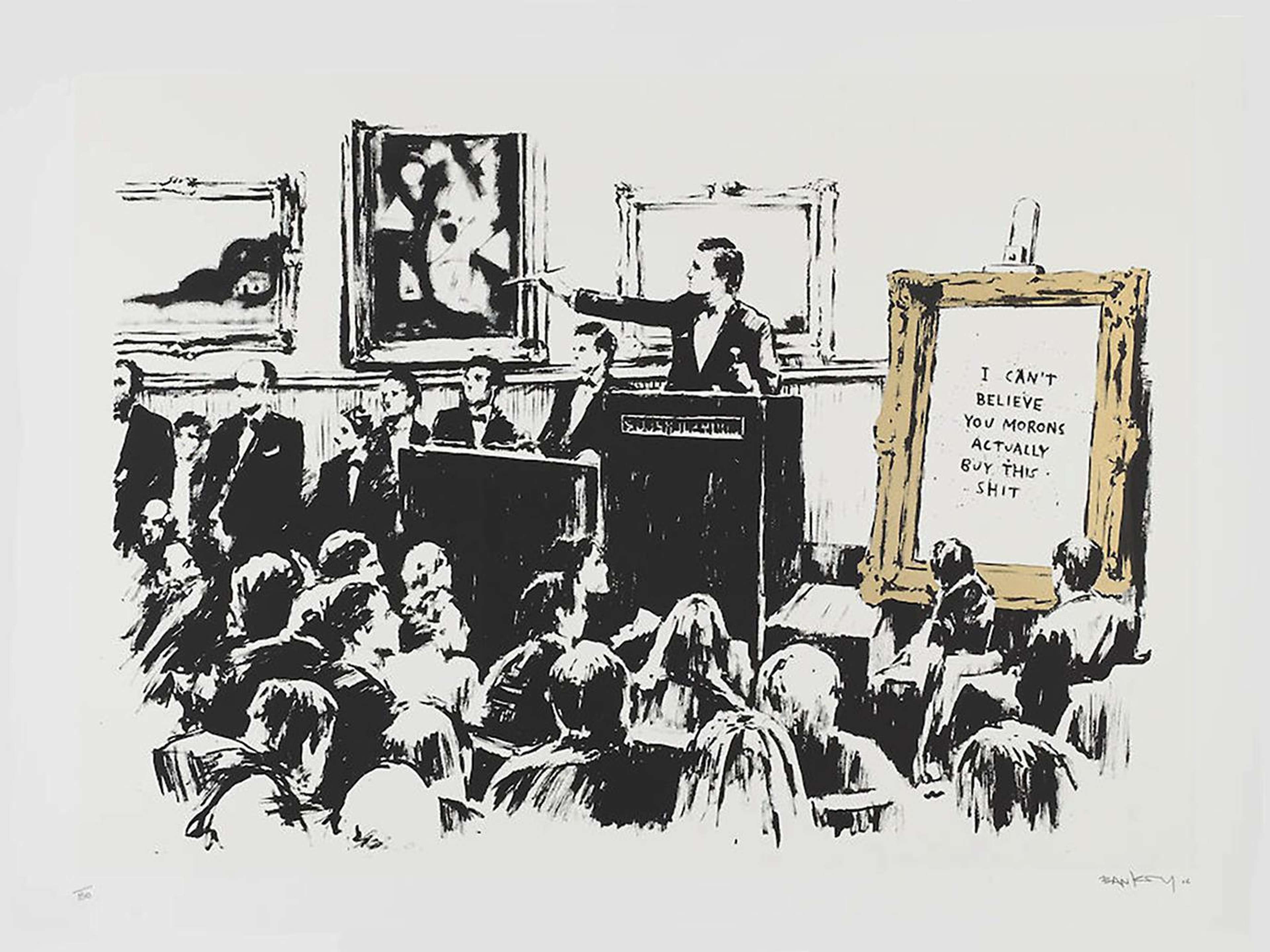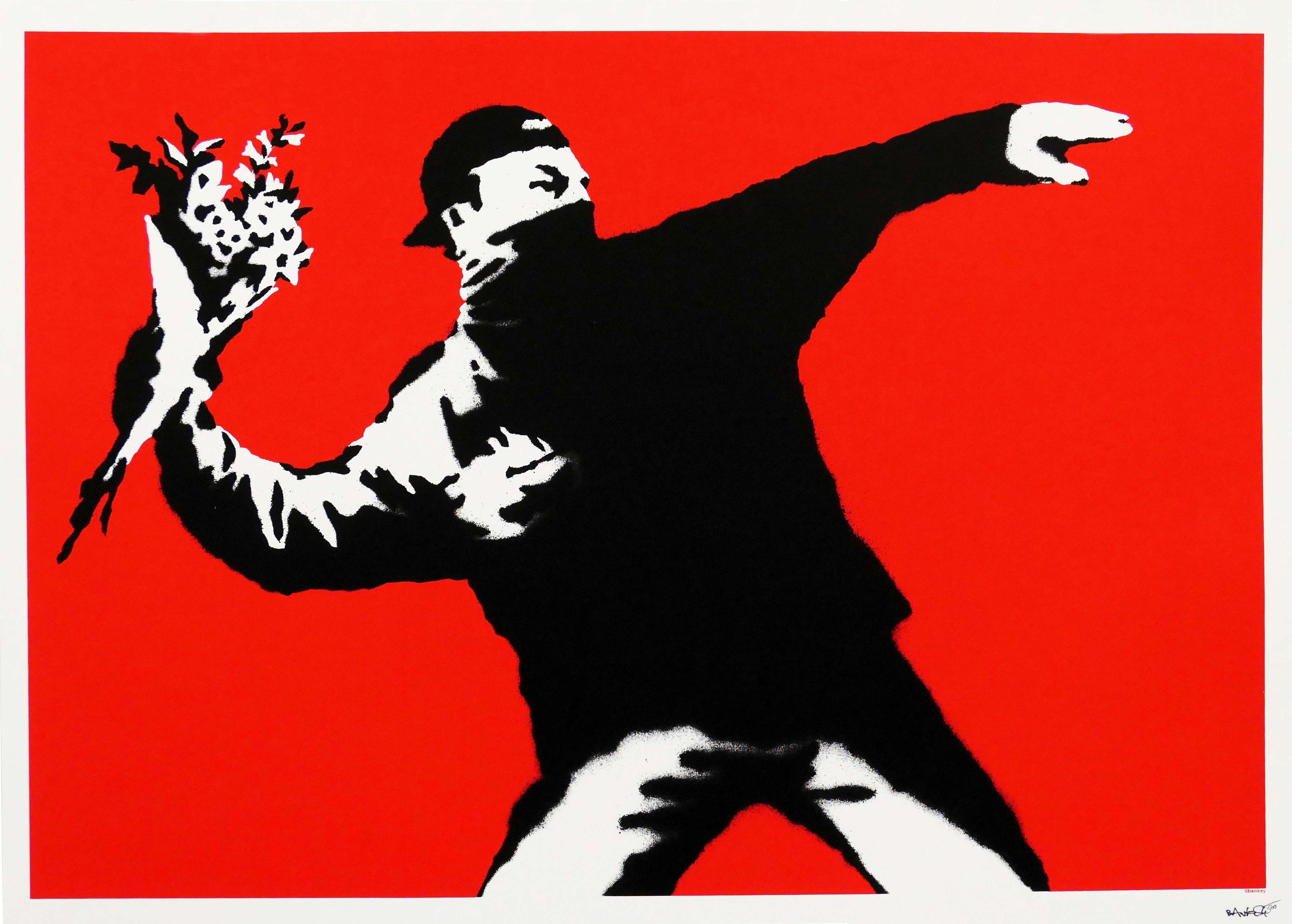The Banksy Story: A BBC Radio 4 Podcast

 The Banksy Story © BBC Radio 4 / BBC Sounds 2023
The Banksy Story © BBC Radio 4 / BBC Sounds 2023
Banksy
269 works
On 17 July 2023, BBC Radio 4 and BBC Sounds released a 10-part podcast alluringly titled: The Banksy Story. Hosted by self-proclaimed ‘Banksy super-fan’ James Peak, he and his soundman, Duncan, promise to get ‘closer than close to Banksy’s secret world’. In conversation with Banksy collectors, art dealers, fellow Street Art fanatics, and even a member of Banksy’s secret team, The Banksy Story follows the meteoric rise of the Bristolian bad boy from vandal to art world sensation. As is always the case with any media coverage about the anonymous artist, the podcast captures the air of mystery so intrinsic to Banksy’s entire career.
Indeed, while the podcast might not answer the most burning question about Banksy - who he really is - Peak’s story is one which ultimately champions Banksy’s anonymity: a crucial necessity for the beloved artist, activist, rebel, stuntman, vandal, and criminal.
Across 10 gripping 20-minute episodes, Peak charts the story of the best kept secret - and greatest success story - of the contemporary art world. In the promo episode, ‘Welcome To The Banksy Story’, our host eagerly asks the most obvious and momentous question of all: “Can you just tell me who he is? Just say his name! Just a tiny little hint…” - but to no avail. Peak’s interviewee answers a series of probing questions: “Has he got any distinguishing features?”, answer: “His anonymity”. “How does he cut loose?”, answer: “He cuts loose by painting where he shouldn’t”. “Is he finished yet?”, answer: “Until he’s dead, no one’s finished are they?”. Finally, “What’s his name?”, answer: “Banksy”.
Interviews and Insights
The interviewee is no mere Banksy fan, but Steph Warren: artist facilitator, curator and owner of Stella Dore Gallery, and a former member of Banksy’s secret printing press Pictures On Walls. Dore’s story, which she was understandably reluctant to tell, underpins The Banksy Story and provides an unprecedented insight into the subversive and adrenaline-fuelled world of Banksy.
Also featuring in the podcast are John Higgs, a cultural historian, and Patrick Nguyen, an art collector who has kept a watchful eye on Banksy since the early years. Here, we delve into each episode of The Banksy Story - following the many previously unheard tales of the maverick artist’s equally covert and overt assault on the art world.
Though each episode is being aired daily on BBC Radio 4, the podcast in its entirety is available to stream on BBC Sounds.
Episode 1: The Mild, Mild West - 17 July 2023
The first episode of The Banksy Story aptly starts in Bristol: Banksy's hometown. Peak introduces himself as a ‘Banksy super-fan’ who has thrown his heart into the street artist's body of work, using the podcast as an opportunity to unpack and understand it. The episode begins with Peak following a Bristolian street artist and engaging in the illicit activity of graffiti, fully immersing himself in the exhilarating - and ultimately illegal - art-form. It was here, after all, that Banksy began to utilise the stencil to its full potential and established his quintessential style.
Banksy's Homage to Bristol's Spirit of Rebellion
One interviewee in the episode describes Bristol as an “anti-establishment community” - a place of historical protest and riot. Since Banksy's rise to fame, Bristol has been the epicentre of many socio-political acts of dissidence: from protests to prevent the opening of a Tesco in 2011, to the toppling of slave trader Edward Colston's statue in 2020. In both instances, Bristol's mobilised defiance lured Banksy to support their efforts. In 2011, Banksy launched a limited poster edition of a lit petrol bomb in a Tesco bottle, the label humorously reading ‘TESCO VALUE PETROL BOMB’. The profits from the £5 poster allegedly went towards funding the legal defence of the 30 rioters that were arrested. Likewise, Banksy released a drop of T-shirts, costing just £25 each, to raise funds for the ‘Colston Four’ accused of damaging the Colston statue.
Since his early days vandalising the streets of Bristol to his heyday as one of the most celebrated artists of our age, Banksy has always made clear his attachment to Bristol. Indeed, Banksy's own anti-establishment sentiments have always mirrored the rebellious spirit of his hometown, and his unwavering support of Bristolian activism is a testament to that.
Episode 2: Love & Death & BMX - 18 July 2023
In the second episode the podcast, we are introduced to Steph Warren at the Boyley Skatepark in Hastings. Named after the BMX legend Richard ‘Boyley’ Ball, Warren's former boyfriend, who sadly passed away after an accident in 2002. It is here that Peak utters that well-known yet somehow forbidden word to Warren: ‘Banksy’. You can hear the hesitation in Warren's voice as she is probed; reluctant to reveal too much about her time spent in Banksy's covert entourage.
According to Peak, it took about a year after this initial meeting for Warren to finally agree to tell her story. In a phone call between the pair, Warren declares: “I've decided to tell you my story, but it might not be the story you want to hear.” Warren's introduction to the world of Banksy was - strangely - normal. After replying to a job listing in the paper for Jo Brooks, Banksy's then-PR Manager, who offered Warren the opportunity to work in a London Banksy exhibition for a neat £75 a day. As Peak observes, Warren clearly did something right during her time as a gallery assistant, as she was then hired by Pictures On Walls (POW) - where she ‘hung out’ with the artist and worked on his exhibitions for several years.
Episode 3: Santa's Ghetto - 19 July 2023
In this episode, we follow Steph's journey towards Banksy's inner circle in this episode, as she ‘proves herself’ at the artist's famed Santa's Ghetto exhibition. This entire episode takes listeners back to the London commercial art world at the turn of the millennium, a time when the Young British Artists (YBAs) were at the height of their success. As John Higgs observes however, many perceived the YBA's work as devoid of emotion - arguing that their work symbolised that “the art world had basically become a branch of the financial industries.” It was this model that Banksy sought to disrupt, compelling the art world with the promise of something different.
Also in this episode, Steph is introduced to Banksy's then-manager Steve Lazarides. The pair were closely involved in Banksy's infamous Santa's Ghetto, a ‘squat art concept store‘ that greeted visitors with a typically tongue-in-cheek sprayed slogan: “Stinking Art Piss”. The concept store was Banksy's first large assault on the traditional gallery, and a sardonic interpretation of the commercial White Cube spaces touting works by the YBAs at the same time. With other super-contemporary street artists exhibiting alongside Banksy's wares, Steph was in charge of selling the artworks on show - with Banksy's Crude Oils on sale for a modest £350 a piece. The show proved two things: the burgeoning popularity of ‘Street Art’ as a serious genre, and the public's speedy embrace of Banksy - both despite, and because of, his anonymity.
Episode 4: Reverse Heists - 20 July 2023
Banksy's New York Stunts
As Banksy takes his barely legal practice abroad, this episode reveals the artist's ‘hilarious reverse heists at the world's best museums and galleries’. A spate of stunts in some of the most esteemed institutions in America, namely the Museum of Modern Art (MoMA), saw Banksy dressed incognito to place his works in the galleries - from defaced oil paintings to taxidermy rats. These shocking and facetious interventions significantly bolstered Banksy's notoriety in the States and established him as a force to be reckoned with.
The Voice of Banksy?
One of the most poignant moments in the entire podcast occurs in this episode: an interview with an individual claiming to be Banksy on a US radio station in the aftermath of his New York stunts. At the beginning of the phone call, the man on the phone tells the American presenters that they have no way of confirming or denying his identity. The man has a ‘Bristolian twang’, which many have taken as confirmation that this was indeed Banksy - the first and only time we have only heard his real voice, perhaps. Identifying himself as a painter and decorator (something which Banksy himself would likely say), the man defends the performative US stunts: “If you wait for other people to latch onto what you're doing, you'd be waiting forever. You might as well cut out the middleman and stick it in yourself.” While we will likely never confirm whether this truly is the voice of Banksy, it is a deliciously teasing shred of evidence for any Banksy fanatic.
Banksy's calculated, subversive antics - coupled with his anonymity - made him an intriguing anti-hero of the art world from the beginning. Banksy never needed the pomp of fancy gallery representation from the likes of Saatchi. He was, and is, firmly in the driver's seat of his own creative direction: the dream of every up-and-coming artist. It was this subversion which propelled him to fame and, ultimately, a rise in his print sales as fans sought to own a piece of Banksy's ethos. And so began the age of ‘flipping’, with prints being bought from POW, marked up for a high profit margin and resold on eBay. Peak calls these profit seekers “a new generation of capitalists disguising themselves as graffiti enthusiasts”. Though this was certainly the case for a lot of Banksy flippers, this dizzying surge in popularity and resale prices was also an indication of Banksy's work beginning to be consumed by the art market. Whether he liked it or not, the monetary value of Banksy's work on the secondary market was beginning to match its socio-political value - and it was happening fast.
Episode 5: Crude Oils - 21 July 2023
Spotlight Story: Banksy's 2005 Crude Oils Show
The fifth episode of The Banksy Story focuses on Banksy's innovative Crude Oils exhibition. Featuring 200 live rats scurrying about the Westbourne Grove gallery floor, this spectacle only remained opened for 13 days to prevent literal pest control. The exhibition brought together Banksy's appropriations of famous oil paintings from art history, democratising art by bringing it to the high street instead of the traditional gallery. Due to the unique setup, only four people could view the exhibition at a time. However, not everyone was impressed. Esteemed art critic Brian Sewell dismissed Banksy and the show as “tacky”. Clearly this was not the sentiment of most, as long queues formed around the block to catch a glimpse of Banksy's work.
Despite his best attempts to debase the art world and market with these spectacles, Banksy was increasingly finding himself being adopted by the major auction houses. As John Higgs argued: “It doesn't matter how much Banksy humiliates the art world by showing it's nothing more than a money generating device. Because Banksy makes money, the art world have to accept him.”
 Sweep It Under The Carpet © Banksy 2006
Sweep It Under The Carpet © Banksy 2006Steph's Stories From Pictures On Walls
Also in this episode, Steph begins to open up about her experiences at POW. Though the Banksy HQ was - undeniably - an exciting environment to be in, it was not immune to the darker underbelly of the art world at large. Steph confesses that she was introduced to heroine while she worked at POW, and became addicted to the drug. Though Banksy himself reportedly spoke to Steph about her predicament, she continued to abuse the drug when alone in the office.
Though Steph's stories about her time working for Banksy are certainly underpinned by her addiction, she also speaks of the joyful atmosphere of POW. Banksy's entourage frequented a local pub together, were gifted prints from every edition, and Steph herself allegedly even became the subject of one of his murals: Sweep It Under The Carpet.
Episode 6: LA Story - 24 July 2023
The sixth episode explored Banksy's defining Barely Legal in Los Angeles in 2006. The show featured a live graffiti-covered elephant, a typically controversial move for Banksy, and attracted a host of celebrity attendees - including Brad Pitt and Angelina Jolie. Clearly, Banksy had officially become a household name and a beloved figure in the art world.
Back in the UK, however, life at Pictures On Walls was becoming increasingly challenging for Steph and the rest of the team. The episode discusses the speculative bubble which emerged in the Banksy market at this time, with people buying his prints in the knowledge that their value would only increase. This phenomenon was fuelled by the Urban Art Association Forum, an online platform where Banksy fans exchanged rumours and gossip about his new print releases and in-situ activity. With thousands of members, Peak likens the Forum to an “obsessive Greek chorus”, with some of members driven by their love for street art and others by the potential profits from selling POW-purchased prints. Lazarides even remarked at the time that these fanatical fans knew more about Banksy than he did.
The episode also described scenes of frantic Banksy fans camping outside POW, leading Steph to comment, “It started to become bigger than anyone could handle.” The skyrocketing value of Banksy's prints created a problem, one which meant Banksy would quickly have to expand his company beyond POW.
Episode 7: A Nightmare on Oxford Street - 25 July 2023
In this episode, we learn about the mayhem that unfurled at the biggest and final Santa's Ghetto in 2006. Fans and flippers mobbed the venue, with hundreds of people spending the night in the cold waiting to get one of the few prints available. The desperation to purchase a print led to queue jumping, intimidation, and even fights breaking out among the show-goers.
This episode marks a turning point for Banksy's career and addresses three main issues: the overwhelming demand for Banksy's work, Banksy's ‘conscious uncoupling’ from Lazarides, and the realisation that POW was no longer fit for purpose. In response, Banksy formed his ‘inner sanctum’: Pest Control. Run by incentivised professionals who could safeguard him, Pest Control was staffed by senior lawyers and heavy hitters who had worked as Hollywood agents. Together, they implemented corporate disciplines and NDAs, helping Banksy to regain control.
Episode 8: Brushed Under The Carpet - 26 July 2023
The eighth episode of The Banksy Story explores a tumultuous period in Banksy's career and its impact on Steph. The episode opens with a public scandal, as Banksy is caught up in an eBay fraud case. This severely damaged their reputation; particularly Steph's, who was wrongly accused of selling counterfeit prints. In the world of street art however, the extensive use of stencils make forgeries all too easy - something Pest Control was increasingly managing.
Despite the controversy, Banksy continued to make bold moves to make sure he was notices, leading Peak to liken him to a modern Robin Hood. The episode highlights his triumphant return to Bristol in 2009, where took over the Bristol Museum & Art Gallery. This move had a significant - though unsurprising - impact on Bristol, with an estimated £12.5-15million spent in the city. The alluring frenzy Banksy created with the public henceforth became known as ‘The Banksy Effect’.
Episode 9: Restoration - 27 July 2023
Following the fraud case that hit Banksy's team, this episode sees Steph being helped by Patrick Nguyen. Nguyen, alarmed by the number of forgeries, compiled a dossier of names and pseudonyms of people who had purchased fake Banksy works and sent it to Pest Control, who subsequently hired him. By working with Trading Standards, Nguyen and Pest Control helped to put an end to the scandal and, thankfully, clear Steph's name.
We then travel back in time to, perhaps, Banksy's most subversive installation: Dismaland. The dystopian theme part was hosted in Weston-super-Mare, the once bleak and rundown seaside town in the UK. Thanks, once again, to 'the Banksy effect' however, the town has since rebranded into an artsy seaside town, likened to Margate and Brighton. By this point in the podcast, we see the full transformative power of Banksy's art: whether transforming the lives of collectors who purchased and resold his prints for profit, or transforming the reputation of places he selected for his welcomed vandalism.
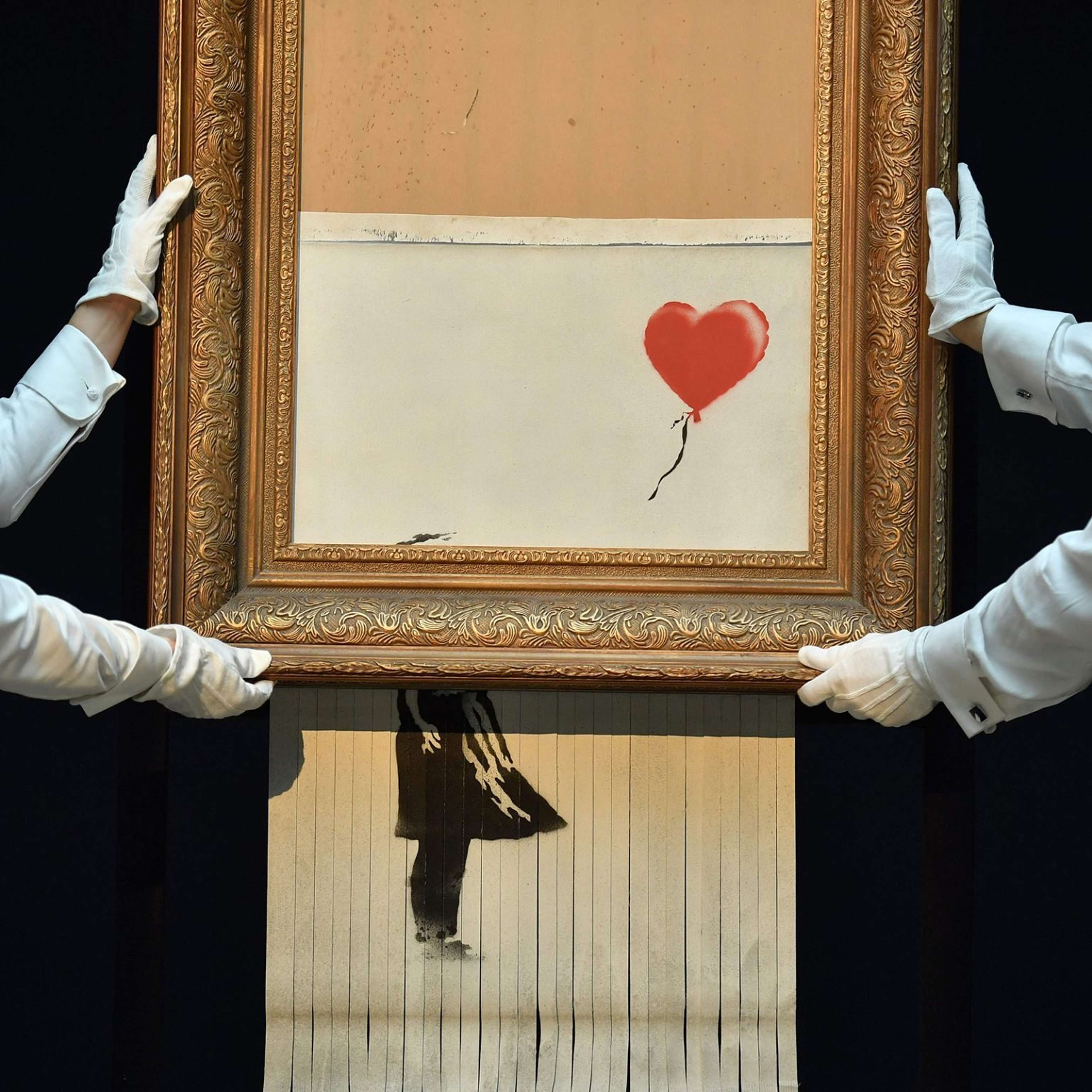 Image © Sotheby's / Love Is In The Bin © Banksy 2021
Image © Sotheby's / Love Is In The Bin © Banksy 2021Episode 10: Who Is He? - 28 July 2023
In the final episode of the podcast, we join Peak in the present day after Banksy surprises fans with his retrospective in Glasgow's Gallery of Modern Art (GoMA): CUT & RUN. We also revisit the iconic 2018 Sotheby's Auction of Girl With Balloon, which Banksy famously shredded the moment it sold for £860,000. The stunt, described as a “sheer fluke”, resulted in what the podcast calls “the preeminent artwork of the early 21st century.” The shredded work, renamed Love Is In The Bin, was later resold for £16 million - a painful irony for Banksy, and a reflection of the art world and market's relishing in his work.
The episode also features a stimulating discussion about the recent Beyond The Streets exhibition held at the Saatchi in London. We are already aware of Banksy's disdain for Saatchi, and so it no surprise that Banksy obviously refused to take part in this glossy retrospective of street art. Peak and Steph attended the opening of the show, but when Peak dared to mention Banksy's name to Roger Gastman - the curator of Beyond The Streets who had previously been involved in Banksy's Barely Legal show - he was forcibly removed. Not long after Beyond The Streets, Banksy's CUT & RUN emerges as a Banksy show dictated by the legend himself - achieving, perhaps, what the Saatchi show failed to. The episode concludes with a debate on whether CUT & RUN signals the peak or end of Banksy's career.
Contrary to Peak's eager attempts to discover Banksy's identity at the beginning of the series, he resolves here that he has stopped asking who he is and no longer wants to discover Banksy's true identity. Peak remarks that unveiling Banksy's real identity would “endanger that rarest of things: an artist who has put himself in the position to say something really important that needs saying. And why would anyone want to ruin that?”
Bonus Episode: The Lost Banksy Interview - 20 November 2023
In a surprise bonus episode of The Banksy Story, James Peak returns with a ‘lost Banksy interview’ from 2003. Conducted by former culture correspondent at BBC Radio 4, Nigel Wrench, this uncovered interview has delighted listeners with the ‘wow factor’ so integral to Banksy's subversive practice. As Peak himself attests: “You may never complete The Banksy Story.”
As the interview is played out on the podcast, listeners are greeted by - perhaps - the most authentic and, indeed, believable recording of Banksy released to date. Recorded shortly before the opening of Banksy's East London assault - Turf War - the interview captures the maverick artist's thoughts on his illegal practice and the world's reception of graffiti. When asked about the anarchic messaging in his Turf War showcase, ‘Banksy’ argues: “It's not so much about anarchism, it's about justice: who has the right to judge anybody else? I like to turn it on its head - I'm into working out who is really the good guy.” Throughout the interview, several instances like this seem to confirm what we already knew about Banksy: the illegality of his art barely phases him, he is a stalwart supporter of the underdog, and he creates art which “takes less time to make it than it takes for people to look at it.”
Also ringing true to our historic speculations about Banksy, Wench goads the elusive artist on his role in the modern art establishment - asking Banksy just what he makes of it, and the likes of Charles Saatchi. In a quippy response to this, Banksy dryly replies: “I still blame him [Charles Saatchi] for Margaret Thatcher and those annoyingly good adverts he made for her. I'm not into that art world, it's not something that interests me.” Indeed, this certainly recalls Banksy's sentiment that the art market's proponents are so-called ‘Morons’ - even though collectors and investors have flocked to purchase his works since the early noughties.
Towards the end of this bonus episode, Peak and Wrench stir particular excitement around the first few moments of the 2003 interview. When Wrench asks Banksy whether or not he can name him as ‘Robert Banks’ in his interview, the artist corrects him and announces his ‘true identity’ to be none other than ‘Robbie Banks’. While the podcast's star, Steph Warren, seems to confirm that this is certainly the voice of Banksy - she remains unyielding when it comes to naming the artist. Indeed, the confirmation of a droll pseudonym is - perhaps - the least interesting aspect of this latest (and likely not the final) instalment of The Banksy Story.
Banksy's Identity Revealed as ‘Robbie Banks’?
A note from the Editor - Erin-Atlanta Argun - 21 November 2023
In the realm of contemporary art, few names stir as much intrigue and debate as that of Banksy. This recent bonus episode of The Banksy Story podcast has reignited this fascination, focusing on what it purports as the ‘true identity’ of the elusive artist - ‘Robbie Banks’. However, at MyArtBroker, we believe that the allure of Banksy extends far beyond the simplistic revelation of a witty pseudonym.
The true essence of Banksy's enigma lies in the paradox which he embodies - a figure who simultaneously rejects and captivates the art establishment. The narrative of ‘Subversion Sells’ echoes through the works of trailblazers like Andy Warhol and Damien Hirst, artists who have harnessed the power of non-conformity and rebellion to redefine the boundaries of art. Yet, Banksy's approach - eschewing both authority and the traditional pathways of the art market - sets him apart.
This juxtaposition of anonymity and market success makes Banksy a unique case study in the world of modern art. His works, often charged with poignant socio-political commentary, not only challenge viewers - but also the very fabric of the art market. Banksy's rejection of the conventional art scene, contrasting his historic market success, is an oxymoron that fascinates collectors and enthusiasts alike.
Here at MyArtBroker, we delve into the intricacies of this phenomenon. Our expertise in the blue chip art market, combined with precision data analysis, allows us to offer unique insights into Banksy's continual market appeal. His ability to remain an enigma while his works fetch record-breaking prices at auction is a true testament to the evolving dynamics of art valuation and collector interest.
Banksy's story, therefore, transcends his identity. It's a narrative about the power of mystery, the appeal of subversion, and the changing tides of art collection and investment. As specialists in navigating the prints and editions market for era-defining artists, we at MyArtBroker are uniquely positioned to analyse the complexities of Banksy's impact on the art world and market.


